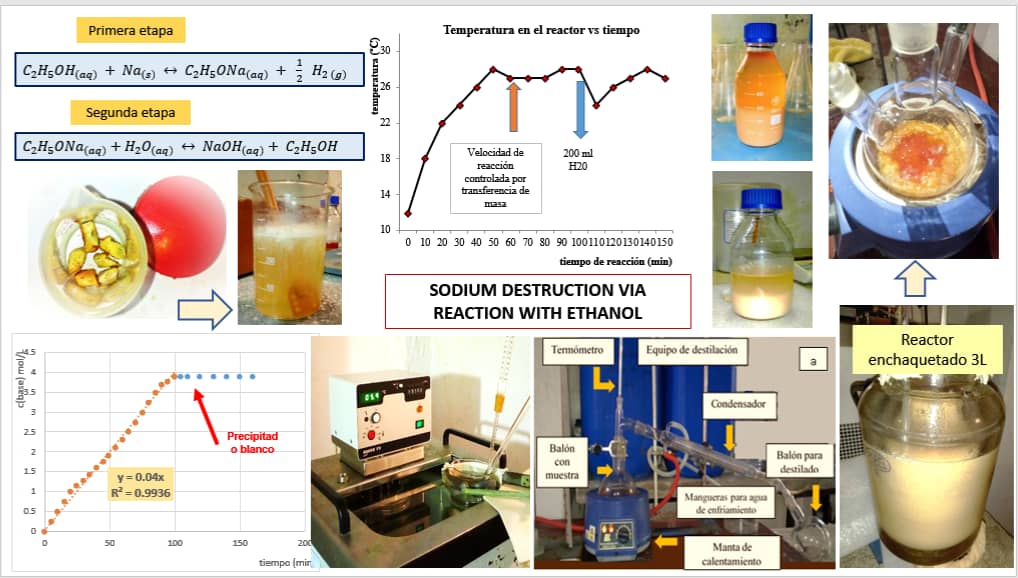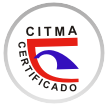EVALUACIÓN DE UN MÉTODO PARA LA DESTRUCCIÓN DE SODIO METÁLICO CADUCO A ESCALA DE LABORATORIO
Palabras clave:
etanol; residuos peligrosos; sodio metálicoResumen
En el presente trabajo se evaluó a escala de laboratorio, en condiciones de seguridad, un método
para la destrucción de sodio metálico caduco. Para ello se estudió, en dos etapas, su reacción con
etanol. Se investigó experimentalmente la variación de la temperatura del sistema de reacción en
función de la velocidad de dosificación del sodio, la relación de la masa de etanol técnico-sodio
en dependencia del por ciento en peso del etanol empleado, la cantidad de agua en la segunda
etapa, y la velocidad de agitación. A partir de este estudio, se precisan los parámetros del método
propuesto, que permiten darle tratamiento a este reactivo en obsolescencia. Finalmente, se realizó
una caracterización elemental del residuo formado, proponiéndose varias alternativas para su
manejo, destacando que más del 98 % del etanol utilizado en la primera etapa, se recupera por
destilación, garantizando su reúso.
Citas
ROGALA, M.; WESIERSKI, T. “Determination of
assumptions for neutralization techniques and
protection of metallic sodium residues in rescue
operation conditions”. Zeszyty Naukowe, SGSP. 2023,
(1): pp. 175-194.
https://doi.org/10.5604/01.3001.0054.1457
DAVID, L. et al. “A small scale experiment and a
simplified model to investigate the runaway of
sodium-water reaction”. Int. J. Heat and Mass
Transfer, 2019, 144, 118542. DOI:
https://doi.org/10.1016/j.ijheatmasstransfer.2019.1185
(hal-02095552).
WHITAKER, K. S.; WHITAKER, D. T. "Sodium
Ethoxide" in: Encyclopedia of Reagents for Organic
Synthesis. 1st Edition. New York. Wiley. 2001. Print
ISBN: 9780471936237, online
ISBN: 9780470842898,
DOI: https://doi.org/10.1002/047084289X.rs070
CHEMICAL BOOK. Chemical Safety Data Sheet
MSDS / SDS. Sodium and Sodium ethoxide. Last
review: January 2025.
https://www.chemicalbook.com/ProductIndex_EN.aspx
Hazardous Substances Data Bank (HSDB). Last
review: 18.01.2025 website:
https://toxnet.nlm.nih.gov/newtoxnet/hsdb.htm
IPCS. The International Chemical Safety Cards,
(last review): 04.11.2024. website:
http://www.ilo.org/dyn/icsc/showcard.home
LAKSHMANAN, A. R. et al. “A novel method of
non-violent dissolution of sodium metal in a
concentrated aqueous solution of Epsom salt”.
Journal of Solid State Chemistry, 2004, 177(10): pp.
-3468, ISSN 0022-4596,
https://doi.org/10.1016/j.jssc.2004.05.030
BRAULT, A. et al. “Destruction of contaminated
metallic sodium wastes by reaction on alcohol and
hydrolysis”. CEA, Centre d'Etudes Nucleaires de
Fontenay-aux-Roses, 92 (France). Dept. de
Protection. 1977, pp. 60-80. OIEA. Report number:
CEA-N--1955. Actualizado y revisado: diciembre
HERRMANN, S. et al. “Controlled Conversion of
Sodium Metal from Nuclear Systems to Sodium
Chloride”, JNFCWT, 2021, 19(2). 233-241. eISSN 2288-5471 / pISSN 1738-1894.
https://doi.org/10.7733/jnfcwt.2021.19.2.233
IAEA-TECDOC-1524. Radioactive sodium waste
treatment and conditioning. IAEA, Vienna, 2007. pp.
-44. ISBN 92-0-116006-2. ISSN 1011-4289.
Printed by the IAEA in Austria, January 2007.
ROESKY, H. W. “A Facile and Environmentally
Friendly Disposal of Sodium and Potassium with
Water”. Inorg. Chem. 2001, 40(26): pp. 6855-6856.
DOI: https://doi.org/10.1021/ic010594m
CHANDRAN, K. et al. “Synthesis and
characterization of sodium alkoxides”. Bull Mater
Sci., 2006, 29, p. 173-179.
https://doi.org/10.1007/BF02704612
CHANDRAN, K. et al. “Standard molar
enthalpies of formation of sodium alkoxides”, J.
Chem. Thermodynamics, 2007, 39(3): pp 449-454.
https://doi.org/10.1016/j.jct.2006.07.024
KESSLER, V.G. “Metal alkoxides as models for
metal oxides-the concept revisited”. J. Sol-Gel Sci
Technol., 2024, 112: pp. 502-511.
https://doi.org/10.1007/s10971-024-06548-w
BESKE, M.; TAPMEYER, L; SCHMIDT, M.
“Crystal structure of sodium ethoxide (C2H5ONa),
unravelled after 180 years”, Chemical
communications, 2020, 56(24): pp. 3520-3523.
https://doi.org/10.1039/C9CC08907A
GHARGE, M. S.; KAMBLE, V. M. “Synthesis
and characterization of sodium alkoxide as organic
reagent”. Journal of Emerging Technologies and
Innovative Research (JETIR). March 2021, 8(3): pp.
-2575. ISSN-2349-5162. eISSN: 2349-5162.
BESKE, M. et al. “Disordered sodium alkoxides
from powder data: crystal structures of sodium
ethoxide, propoxide, butoxide and pentoxide, and
some of their solvates”. Structural Science, Crystal
Engineering and Materials. 2021, 77(Part 1): pp. 68-
ISSN: 2052-5206.
https://doi.org/10.1107/S205252062001584X
RANDRIANA, N. R.;
RANDRIANOMENJANAHARY, A. M;
RABEHARITSARA, A. T. “Sodium Ethoxide
Concentrated Solution Synthesis at Ambient
Temperature Using Sodium Hydroxide and Ethanol90 in Excess”. World Journal of Applied Chemistry,
, 6(1): pp. 6-11. ISSN: 2637-5982.
https://doi.org/10.11648/j.wjac.20210601.12
SHANDONG HUIHAI PHARMACEUTICAL
& CHEMICAL Co. Ltd. “Preparation of metal
alcoholates by converting hydroxy groups to Ometal groups” Denomination of invention: A
preparation method of sodium ethoxide. Patent:
[C07C29], R. P. China, Registration number:
Y2021980013568, 2021-11-30.
DAVID, L.; MILANOVIC, M.; HERVE, P. et al.
“Spectroscopic, pressure and temperature
measurements of the reactant mixing process in
sodium-water reaction”. Nuclear Eng. and Design,
364, 110638.

Descargas
Publicado
Cómo citar
Número
Sección
Licencia
Derechos de autor 2025 Yamell Jiménez-Prieto, Guillermo Esperanza-Pérez, Surey Ramírez-González, Javier Martin-Santin, Juan A. Ribalta-Quesada

Esta obra está bajo una licencia internacional Creative Commons Atribución-NoComercial-SinDerivadas 4.0.
Esta revista proporciona un acceso abierto inmediato a su contenido, basado en el principio de que ofrecer al público un acceso libre a las investigaciones ayuda a un mayor intercambio global de conocimiento. Cada autor es responsable del contenido de cada uno de sus artículos.






















